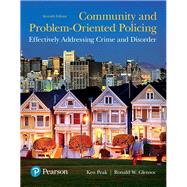Community and Problem-Oriented Policing Effectively Addressing Crime and Disorder
, by Peak, Ken J.; Glensor, Ronald W.- ISBN: 9780133590104 | 0133590100
- Cover: Paperback
- Copyright: 1/12/2017
For courses in Community Policing and Police-Community Relations
An applied, timely approach to “what works” in addressing crime and disorder
Community and Problem-Oriented Policing: Effectively Addressing Crime and Disorder, Seventh Edition,
is about policing at its most important and challenging levels–in neighborhoods and communities across the nation. Unique in perspective, its focus is on community- and problem-oriented policing and the processes that are being implemented to control and prevent crime, disorder, and fear. Every chapter features Learn by Doing exercises to promote critical-thinking and analytical skills. Extremely applied, this text focuses on daily processes and tactics and how and why agencies are revolutionizing their traditional philosophy and operations.The Seventh Edition addresses head-on the most challenging aspects of policing in our age. Individual chapters focus on community policing in terms of diversity, terrorism, homeland security, and police being more constitutional and legitimate. Expanded emphasis is placed on smart policing, predictive policing, and intelligence-led policing as well as applications of new information technologies for problem solving. Additionally, chapters examine major issues and challenging crime problems (e.g., drugs, gangs, youth and crime, neighborhood disorder, domestic violence, and human trafficking), crime prevention, changing agency culture, evaluating problem-solving initiatives, cyberbullying and cybercrime, and special populations, and the future. New case studies, exhibits, and examples offer readers a view of what works in policing strategy and problem solving in the field today.






